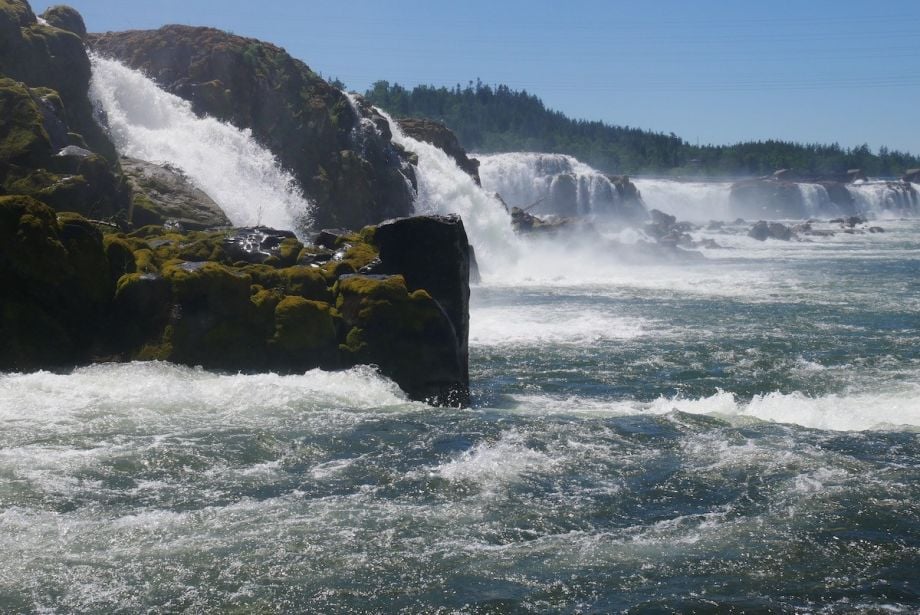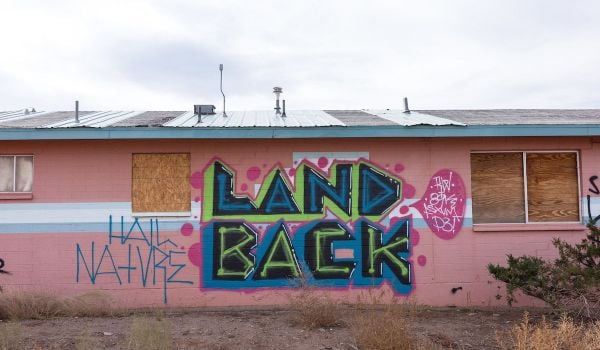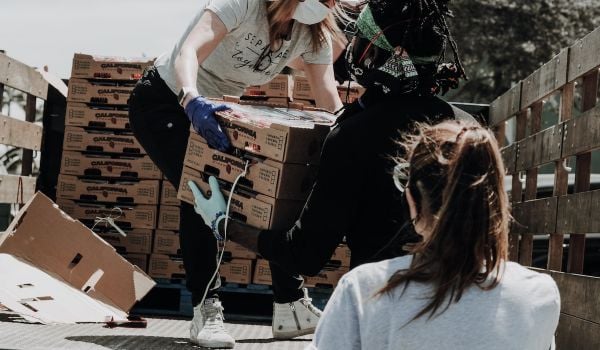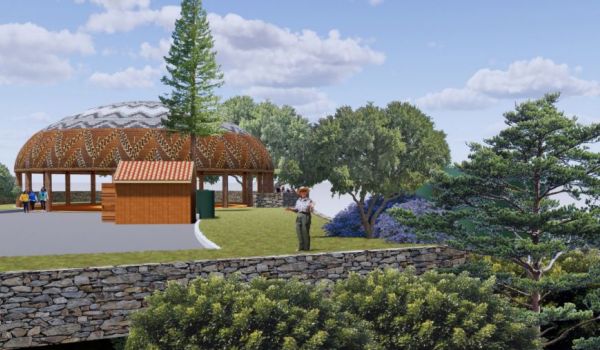This story originally appeared on Underscore News.
On a cloudy September morning, dozens piled into kayaks, stand-up paddle boards and a canoe near the base of Willamette Falls. As they took to the water, Gerard Rodriguez, Yaqui and Nahua, spoke about the river and the importance of the falls to local tribes.
“This is a very important place that connects all of Indigenous country here in Oregon,” said Rodriguez, associate director and director of tribal affairs at the Willamette Falls Trust, a megaphone projecting his voice across the water. “This is an intertribal area that connects many different tribes — the Yakama Nation, the Warm Springs people, Umatilla, Siletz, Grand Ronde and Nez Perce. So welcome here, to Indigenous land.”
The trip was part of the four-day Land Trust Alliance Rally, an annual conference where hundreds of representatives from land trusts from across the country gathered. It came the day after an unofficial part of the rally: a summit where nearly 100 Indigenous leaders discussed the historic problems with land trusts, most notably the lack of Indigenous values and leadership, and how organizations should be doing it better.
At the Indigenous Land Conservation Summit, participants envisioned a future where Indigenous voices and values are central to conversations about land protection, and how they overlap with Land Back efforts.
“Today’s purpose is really making a space for Indigenous land practitioners who belong in this community of land trusts but are excluded from it,” said Anna-Liza Victory, Cherokee, summit organizer and Oregon Land Justice Project manager.
Land trusts: acquisition and preservation
Like many spheres in the climate activist world, land trusts have typically been dominated by white-led organizations. And as some Indigenous people at the event on Wednesday expressed, for that reason these spaces have not always felt welcoming.
“The Land Trust Alliance, the group that holds the rally, stewards about 90 land trusts who own a good chunk of what’s now known as the United States,” said Gabe Sheoships, Cayuse/Walla Walla tribal citizen of the Confederated Tribes of the Umatilla Indian Reservation, executive director at Friends of Tryon Creek. “A large majority aren’t [Indigenous led] and don’t have relationships with tribes, don’t know about tribes in general.”
Land trusts are conservation organizations that focus on land acquisition and preservation, traditionally using a model of conservation easements. A conservation easement is an agreement between a private land owner and a land trust or government agency that limits the use of the land and allows the property owner to retain many private property rights.
So a land owner might make an agreement with a land trust to hold their land, in order to protect and preserve it in perpetuity.
But baked in are ideas that originate in colonial culture – some of the same ideas that created the need land trusts seek to fill.
Many land trust projects don’t include public access to land. When they do, there is often an idea that human access should be limited in order to preserve the land, according to Victory. Land trusts usually prioritize activities like hiking, while limiting the ability to hunt, fish and gather food and medicine. This excludes Indigenous people and their inherent right to the land, as well as their knowledge as stewards of the land since time immemorial.
Limiting those activities erases their value as stewardship activities, Rodriguez said.
“The word conservation is extremely problematic because we’re not conserving the land for non-human interaction. That’s a very Western idea,” Rodriguez said. “As Indigenous people, we think about how humans and our populations have always been, to use one of their terms, a keystone species, just like every other part of the circle.”
In that sense, conservation easements are contrary to the efforts of the Land Back movement, perpetuating colonial ideas of land ownership and of an inherent separation between humans and the land that makes restricting their interactions a good thing.
“[Land trusts] need to get away from conservation easements and that feeling that there is always going to be a need to control how Indigenous people are on the land,” Victory said.
Indigenizing land trusts
Oregon is home to over 25 land trusts, according to the Coalition of Oregon Land Trusts website. Collectively, land trusts in Oregon own around 2 percent of the state while the nine federally recognized tribes in Oregon own only around 1 percent, according to Sheoships.
With a goal to counter this and expand Indigenous access, ownership and land stewardship, the Oregon Land Justice Project formed in 2020.
Before the project launched into land justice work, land trusts from around the state spent nine months hearing from Indigenous speakers and educating themselves about the history of Native land loss. The group focused on learning how land trusts run by non-Native people can move toward Indigenous-centered efforts.
Now, the project is involved in a variety of land justice efforts, most recently through a newly established fund called the Indigenous Land Relationship Fund. The goal of the fund is to support Indigenous-led projects to reconnect with land, culture and first foods.
“Our idea was an inter-tribal, statewide collective that would be able to work with folks in different geographic areas, cultural areas, navigating tribal histories and different tribal relationships,” said, Sheoships, facilitator at the Oregon Land Justice Project. “Our teachings to the land trusts encompassed all of that, kind of modeled after other projects in the country.”
Oregon Land Justice Project works with land trusts across Oregon to educate, build relationships and create organizational change, shifting the model of land trusts and creating space for Indigenous leadership to be front and center.
The project is inspired by First Light New Learning Community, based in Maine. First Light is made up of the land trust community in Maine and the Penobscot, Passamaquoddy, Maliseet and Micmac communities of the Wabanaki Confederacy, working to return land to Wabanaki people.
Representatives from First Light were at the Tribal Summit, where they shared some of the organization’s work serving as a bridge between conservation organizations and the Wabanaki Confederacy.
“It’s the most amazing opportunity to have this idea of land returning to us and working with land trusts who, up until this point, I think a lot of Indigenous people, we saw them as on the ‘taker’ side of this equation,” said Darren Ranco, Penobscot, a member of the planning team for the Wabanaki Commission on Land and Stewardship. “For them to recognize a role in that and then a responsibility to Native people, it’s been really amazing.”
In Maine, 90 percent of the land is privately owned and 23 percent is stewarded by conservation organizations, while the Wabanaki people only legally steward 1.2 percent of their ancestral lands, according to First Light.
This year, First Light has helped facilitate the return of 40,000 acres to the Wabanaki people. The organization also made a $1 million deposit into a new fund, the Land Recognition Fund, which will be held by the Wabanaki commission to make grants that help deepen connection with the land.
“Returning land is only the first step,” said Peter Forbes, founder of First Light.
A beacon for tribal communities
Though Willamette Falls Trust hosted a field trip during the Land Trust Alliance Rally, it’s not actually a land trust. In working to create public access for the first time in nearly two centuries at the second largest waterfall by volume in North America, the Willamette Falls Trust is guided by Indigenous leaders and the human relationships intertwined with the culturally and historically important site. The land where the project will be developed – an island on the west side of Willamette Falls – is still owned by Portland General Electric. PGE runs a power plant at the falls.
The project at Willamette Falls began as a conversation between four local municipalities about creating access to the falls for their constituents — it has since evolved to being tribal-led, with a recognition of the deep significance of this site for local Indigenous tribes.
First and foremost, the goal of the project at Willamette Falls is to expand access for Indigenous people, which will in turn expand access to the falls for everyone.
Participants in the kayak trip to the falls discussed whether Willamette Falls Trust may be an example of a different, and perhaps better, model.
“I think of this project here, with Willamette Falls Trust and the tribes and jurisdictions, as a paradigm for how land trusts could be involved,” Owen Wozniak, land transactions program manager at the Land Trust Alliance, said during the trip.
Despite the work of groups like Oregon Land Justice Project, many land trusts across the country, and most who attended the Land Trust Alliance Rally, are not Indigenous-led. In that context, Willamette Falls Trust could serve as an example of how to transition any public access project to a model based on collaboration and shared leadership with local tribes.
“We want this to be a beacon for tribal communities, a success for all Indigenous people on this land, to be able to recognize that we always can change the way that we interact with others, lean into our sovereignty and lead from a place of Indigeneity,” Rodriguez said.
Underscore is a nonprofit collaborative reporting team in Portland focused on investigative reporting and Indian Country coverage. We are supported by foundations, corporate sponsors and donor contributions. Follow Underscore on Facebook and Twitter.
Nika is a journalist with a passion for working to provide platforms for the voices and experiences of communities often left behind in mainstream media coverage. Most recently, she worked as the health and social services reporter at The Columbian in Vancouver, Washington. Prior to working at The Columbian, Nika spent the summer of 2022, after graduating magna cum laude from the University of Oregon with a degree in journalism, working as a Snowden Intern at The News-Review in Roseburg, Oregon. A descendant of the Osage and Oneida Nations, Nika was born and raised in Portland. Her favorite way to unwind is by trying a new recipe, curling up with a good book or taking a hike in one of the many green spaces around Portland.
Follow Nika .(JavaScript must be enabled to view this email address)














